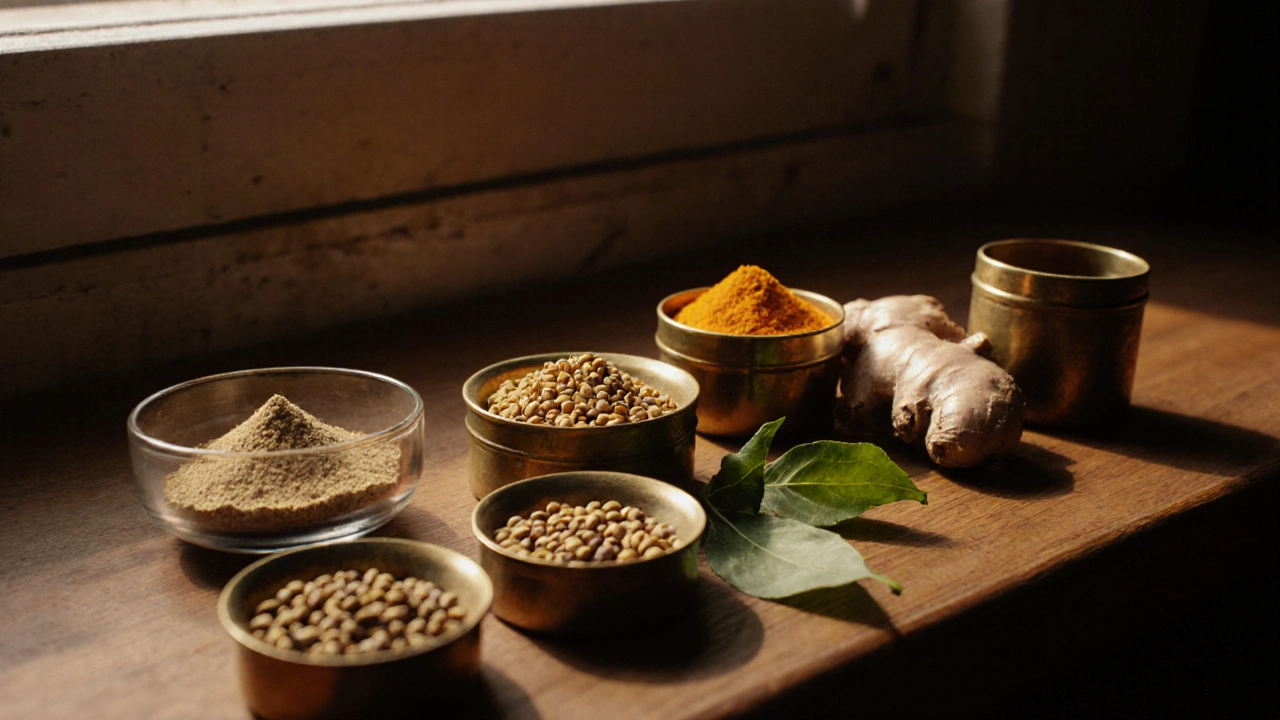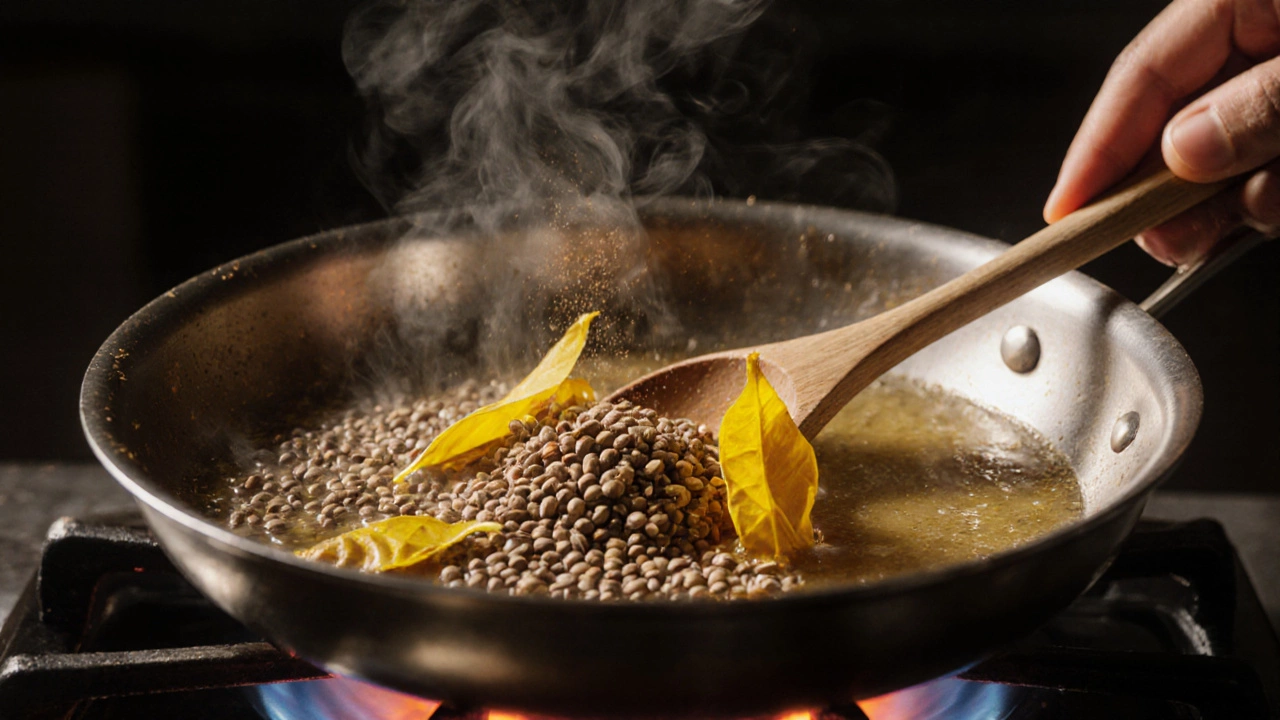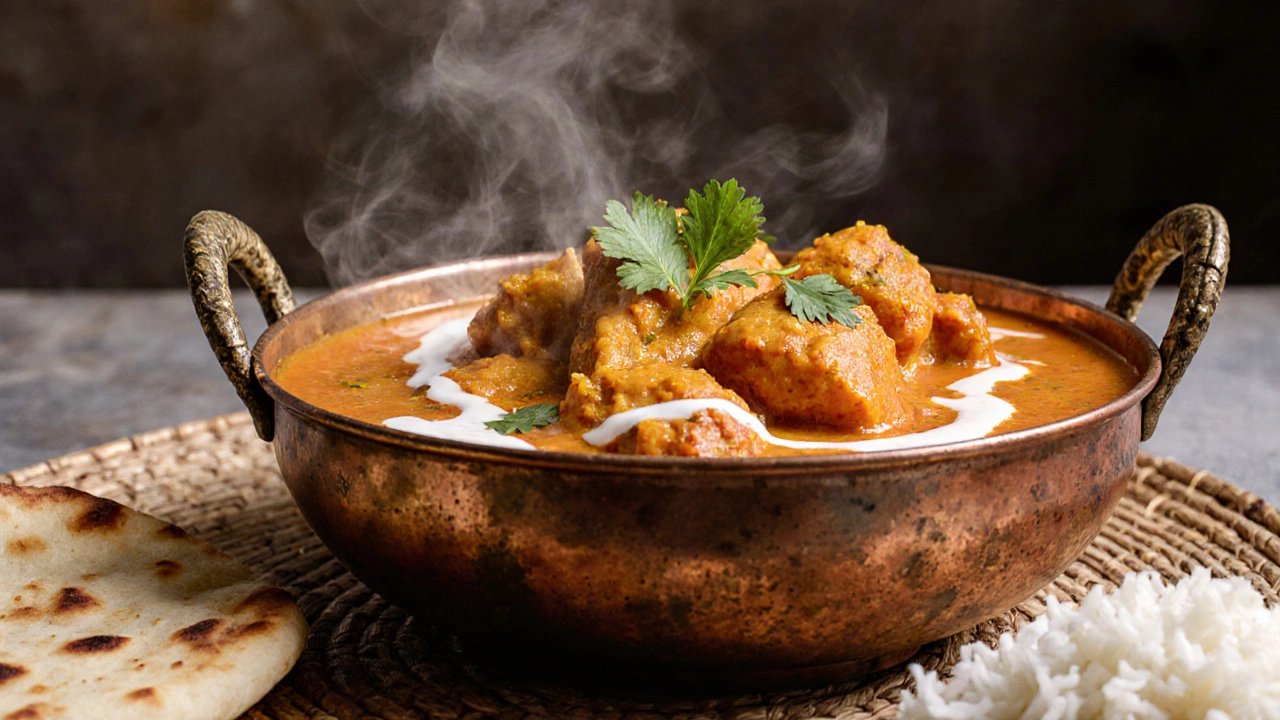Garlic Substitutes in Indian Cooking: Flavorful Alternatives for Chicken Curry

Garlic Substitute Calculator
Calculate exact substitute measurements for your Indian chicken curry recipe. Enter number of garlic cloves to replace
Substitute Amounts
Use a pinch (1/4 tsp) per clove
Grate fresh ginger before use
Based on article ratios: Asafoetida (1/4 tsp per clove), Ginger (1/2 tsp), Cumin (1/4 tsp), Mustard (1/2 tsp), Curry leaves (5-6 per clove)
Key Takeaways
- Garlic is often avoided for religious, health, or allergy reasons, but Indian cuisine offers many natural substitutes.
- Asafoetida (hing) provides the closest umami punch; use it sparingly.
- Fresh ginger, mustard seeds, and curry leaves can build layered flavor without garlic.
- A simple garlic‑free chicken curry can be ready in under 45 minutes.
- Adjust proportions with the cheat sheet below to match your taste.
When you search for "what do Indians use instead of garlic?" the answer isn’t a single spice - it’s a toolbox of aromatics that can recreate the depth garlic gives while respecting dietary restrictions. Below you’ll find the why, the what, and a step‑by‑step garlic substitute chicken curry that works for anyone who skips the clove.
Why Skip Garlic?
Garlic is a staple in many Indian dishes, but several reasons make cooks leave it out:
- Religious observance: Some Jain households avoid all root vegetables, including garlic, because they are believed to stimulate passions.
- Health concerns: Garlic can aggravate acid reflux, cause allergic reactions, or interfere with blood‑thinning medication.
- Flavor balance: In delicately spiced dishes, a strong garlic bite can overpower subtle notes.
Whatever the reason, Indian kitchens have evolved a set of reliable stand‑ins. Let’s meet them.
Top Garlic Substitutes in Indian Cooking
Each substitute brings a unique profile. Below is a quick guide, followed by a comparison table that lets you pick the right one for your chicken curry.
Garlic is a bulbous Allium species known for its pungent, spicy flavor that mellows when cooked. Asafoetida (hing) is a resin harvested from Ferula plants. It smells sulfurous raw but turns buttery and umami when heated. Ginger is a rhizome with bright, citrusy heat. Fresh ginger adds zest without the lingering after‑taste of garlic. Cumin seeds are dried fruit of the Cuminum cyminum plant, delivering earthy, warm notes that help fill the flavor gap. Mustard seeds are small, round seeds that pop and release a sharp, slightly bitter tang when toasted. Curry leaves are aromatic leaves from the Murraya koenigii tree, imparting a subtle, sweet‑herbaceous flavor. Chicken curry is a stew‑like dish where chicken pieces simmer in a spiced gravy, often featuring tomatoes, onions, and a blend of whole and ground spices. Coconut milk is the thick, creamy liquid extracted from grated coconut, used to mellow heat and add richness.| Substitute | Flavor Profile | Typical Use in Curry | Ratio to Garlic (1 clove) |
|---|---|---|---|
| Asafoetida (hing) | Umami, slightly sulfuric, becomes buttery when cooked | Added at the start with oil; a pinch is enough | ¼ tsp pinch |
| Ginger (fresh) | Citrusy, warm, mildly sweet | Grated or finely chopped with onions | ½ tsp grated |
| Cumin seeds (ground) | Earthy, nutty | Toasted then ground into the spice mix | ¼ tsp |
| Mustard seeds | Sharp, slightly bitter | Temper in hot oil before adding other aromatics | ½ tsp |
| Curry leaves | Sweet‑herbaceous, subtle | Temper with mustard seeds for a fragrant base | 5‑6 leaves |

Garlic‑Free Chicken Curry Recipe
Here’s a complete, beginner‑friendly recipe that showcases the substitutes above. The steps assume you have basic kitchen tools and spices on hand.
- Gather ingredients (serves 4):
- 500 g chicken thigh or breast, cut into bite‑size pieces
- 2 tbsp oil (vegetable or mustard)
- ½ tsp mustard seeds
- 5‑6 curry leaves
- ¼ tsp asafoetida (hing) - use a pinch
- 1 medium onion, finely chopped
- 1 tbsp fresh ginger, grated
- 1 tsp ground cumin
- 1 tsp ground coriander
- ½ tsp turmeric powder
- 1 tsp red chili powder (adjust to heat)
- 2 medium tomatoes, pureed
- 200 ml coconut milk
- Salt to taste
- Fresh cilantro for garnish
- Temper the aromatics: Heat oil in a deep pan over medium heat. Add mustard seeds; when they start popping, toss in curry leaves and the pinch of asafoetida. Stir for a few seconds - you’ll smell a nutty, slightly sweet aroma.
- Sauté onions and ginger: Add the chopped onion. Cook, stirring, until golden brown (about 5‑6 minutes). Then stir in the grated ginger and cook another minute.
- Build the spice base: Sprinkle cumin, coriander, turmeric, and red chili powder. Stir continuously for 30‑45 seconds; this ‘blooming’ releases the oils and prevents burning.
- Introduce tomatoes: Pour the tomato purée, stir, and let the mixture simmer until the oil separates from the masala (about 4‑5 minutes). This indicates the flavors have melded.
- Add chicken: Drop the chicken pieces into the pan, coating them well with the masala. Cook for 3‑4 minutes until the chicken starts to brown.
- Finish with coconut milk: Reduce heat to low, pour in coconut milk, and gently stir. Cover and simmer for 12‑15 minutes, or until the chicken is tender and the gravy thickens. Taste and adjust salt.
- Garnish and serve: Sprinkle chopped cilantro on top. Serve hot with basmati rice, chapati, or naan.
Tip: If you prefer a thicker gravy, let the curry cook uncovered for the last 5 minutes. If you like a thinner sauce, add a splash of water or extra coconut milk.
Practical Tips & Common Pitfalls
- Don’t over‑use asafoetida: A little goes a long way. Too much can taste soapy.
- Balance heat: Ginger adds warmth, so you may need less chili powder than in a garlic‑based version.
- Toast whole spices (mustard seeds, cumin) briefly before grinding; this unlocks deeper flavor.
- Freshness matters: Old ginger loses its bright bite, and stale curry leaves become dull.
- Adjust salt after adding coconut milk because the milk can mask seasoning.

Quick Cheat Sheet: Garlic Substitutes Ratio Guide
- Asafoetida: ¼ tsp pinch per clove of garlic.
- Fresh ginger: ½ tsp grated per clove.
- Ground cumin: ¼ tsp per clove (use with other spices).
- Mustard seeds: ½ tsp tempered per clove.
- Curry leaves: 5‑6 leaves per clove.
Frequently Asked Questions
Can I use garlic powder instead of fresh garlic?
If you only need the flavor and not the texture, a pinch of garlic powder works, but it defeats the purpose of a garlic‑free dish for those with dietary restrictions. Stick to the natural substitutes listed above for authentic Indian taste.
Is asafoetida safe for children?
Yes, in the tiny amounts used for tempering it’s safe for all ages. However, always start with a very small pinch; the flavor can be overwhelming if over‑done.
What if I’m allergic to mustard seeds?
Swap mustard seeds for a few more curry leaves and a dash of ground fenugreek. The fenugreek adds a slightly bitter note similar to mustard.
Do these substitutes work in vegetarian curries too?
Absolutely. The same aromatics create depth in lentil, paneer, or vegetable curries. Just adjust the cooking time for the main ingredient.
How long can I store the leftover garlic‑free curry?
Cool it quickly and refrigerate in an airtight container for up to 3 days. Reheat gently; coconut milk can split if boiled too hard.